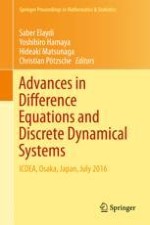This volume contains the proceedings of the 22nd International Conference on Difference Equations and Applications, held at Osaka Prefecture University, Osaka, Japan, in July 2016. The conference brought together both experts and novices in the theory and applications of difference equations and discrete dynamical systems. The volume features papers in difference equations and discrete dynamical systems with applications to mathematical sciences and, in particular, mathematical biology and economics. This book will appeal to researchers, scientists, and educators who work in the fields of difference equations, discrete dynamical systems, and their applications.
